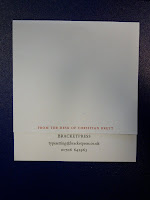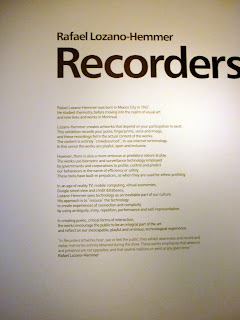






'The Cabinet of Curiosity'

“You cannot experience your own interior by closing your eyes and concentrating on it. In order to discover your own contents you have to investigate the inside of someone elses” -Jonathan Miller
[210mm x 148mm, pp. 18, card cover with tissue wrapper]. Edition of 50
I recently purchased a beautiful item from 'Bracketpress' – and edition of 50 by Alice Smith, which contains a series of visceral explorations, named, Tissues & Bones. The booklet contains full bleed illustrations, with a card cover, aptly encased in tissue and secured with a silver/grey ribbon. I also got sent a compliments card 'from the desk of Christian Brett', which I thought was a great touch.
Inspiring!
Here is issue 9.





 I got commissioned to create exhibition signage for a community project at the contact theatre. This was insightful as it gave me an idea about working in the real world and preparing files to send to an external printer. It was strange not having complete creative freedom, but was good practice working within such restrictive guidelines and still try to make something creative. I was pleased to find out that I would be paid for this work, making this my first ever paid graphic design job. I learnt a lot about how to prepare a document for printing, simple things which aren't relevant in a university envoronment, but are very important in the outside world.
I got commissioned to create exhibition signage for a community project at the contact theatre. This was insightful as it gave me an idea about working in the real world and preparing files to send to an external printer. It was strange not having complete creative freedom, but was good practice working within such restrictive guidelines and still try to make something creative. I was pleased to find out that I would be paid for this work, making this my first ever paid graphic design job. I learnt a lot about how to prepare a document for printing, simple things which aren't relevant in a university envoronment, but are very important in the outside world.
Static;
inert, motionless, stagnant, stationary, immobile, fixed, constant, changeless were a few words to trigger the ideas process. When I considered further I thought about ideas of interference and interruption, at first in a conventional sense, but what if interference and interruption were applied to something else.
Four key words describe my interpretation of static.
Interference
Routine
Possession (s)
Influence.
How could I interfere with a step by step process, perhaps removing a step or interrupting a step. Shaking the printer whilst it was printing, moving an image whilst it was scanning, drawing something, perhaps rubbing it out DeKooning-style. I began taking photographic slides and interfering with the developing process. Scratching the slides, obstructing with shapes, covering faces with fish net, drawing pins and electrical tape. Even removing the film altogether and creating photo-grams from my belongings.

From interference I began to look at influence. How an influence can be an interference within someone’s life. Everyone is exposed to millions of different influences. Another type of interruption of process, the process being our lives. I wanted to map my own influences, painstakingly attempting to collate everyone who's ever influenced me. I decided to hone in on artistic influences and then eventually feminine influences, mapping each woman who has inspired me and trying to smash and collide these images together to create an amalgamated female form

 I thought about how routine can be something static, people develop a living pattern, have rituals, obsessions, these can be quite mundane things, I thought about how I could map my own routine, instead of it being mundane, it would have a new context and perspective, allowing me to re-think and analyse.
I thought about how routine can be something static, people develop a living pattern, have rituals, obsessions, these can be quite mundane things, I thought about how I could map my own routine, instead of it being mundane, it would have a new context and perspective, allowing me to re-think and analyse.

I needed a way to bring all of these these themes together in one coherent way, I decided on the idea of a book-box format. The box resembles an expander file, hinting at the archival nature of the contents, and inside each word is represented by a separate entity of beak book, each book has a definition of the word and my response.




 Richard Hamilton, typographical represention of Marcel Duchamp's 'The Green Box"
Richard Hamilton, typographical represention of Marcel Duchamp's 'The Green Box"







 I first came across Barney Bubbles when Hitch (my tutor) imparted some of his creative influences to us in a lecture, therefore I was really looking forward to hear a lecture from the author of the book, 'Barney Bubbles: Reasons To be Cheerful,' Paul Gorman.
I first came across Barney Bubbles when Hitch (my tutor) imparted some of his creative influences to us in a lecture, therefore I was really looking forward to hear a lecture from the author of the book, 'Barney Bubbles: Reasons To be Cheerful,' Paul Gorman.
 Teal Triggs came to talk to us about her recently released book entitled 'fanzines.' I thought that her research on the subject was of course impressive and she had covered an extensive range of zines from all over the world. I expected Triggs to gives us a little more of an insight into zine culture, rather than talk us through the titles of a long list of zines and for this reason I found the lecture less interesting. I do engage with zines and having an avid interest in photo-montage come hand in hand with zine culture with artist such as Linder Sterling and I have made some myself in the past, they are a great way of collating together information and some of the better ones are great for making political and social statements. I think if Triggs had spoken more extensively about the sub-culture of zines this would have been more interesting, but instead I found the talk quite tedious towards the end.
Teal Triggs came to talk to us about her recently released book entitled 'fanzines.' I thought that her research on the subject was of course impressive and she had covered an extensive range of zines from all over the world. I expected Triggs to gives us a little more of an insight into zine culture, rather than talk us through the titles of a long list of zines and for this reason I found the lecture less interesting. I do engage with zines and having an avid interest in photo-montage come hand in hand with zine culture with artist such as Linder Sterling and I have made some myself in the past, they are a great way of collating together information and some of the better ones are great for making political and social statements. I think if Triggs had spoken more extensively about the sub-culture of zines this would have been more interesting, but instead I found the talk quite tedious towards the end.










